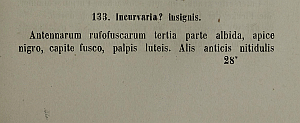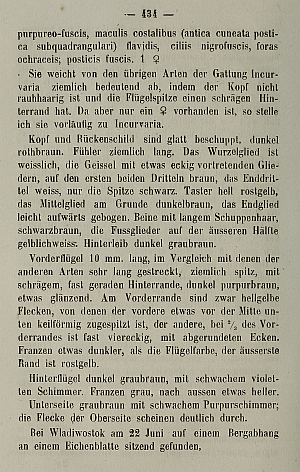

 +2Kontinente:EUAS
+2Kontinente:EUAS3. Biologie
3.1. Nahrung der Raupe
Noch unbekannt! Die Fundumstände in der Slowakei könnten einen Hinweis darauf liefern, dass auch diese Art in faulendem Holz lebt: "The study specimen was found by the third author during afternoon hours on an old rotting trunk of hornbeam (Carpinus betulus) situated in the middle of the forest."
(Autor: Erwin Rennwald)
4. Weitere Informationen
4.1. Andere Kombinationen
- Incurvaria insignis Christoph, 1882 [Originalkombination]
4.2. Taxonomie und Faunistik
Christoph (1882: 433) führte die Art als "Incurvaria ? insignis" ein. Er vermerkte dazu: "Sie weicht von den übrigen Arten der Gattung Incurvaria ziemlich bedeutend ab, indem der Kopf nicht rauhhaarig ist und die Flügelspitze einen schrägen Hinterrand hat. Da aber nur ein ♀ vorhanden ist, so stelle ich sie vorläufig zu Incurvaria." Zum Fundort war zu erfahren: "Bei Wladiwostok am 22 Juni auf einem Bergabhang an einem Eichenblatte sitzend gefunden". Lvovsky & Sinev (2011) überführten das Taxon in ihre neue Gattung Paradasycera. Sie schrieben dazu: "In the well-known catalogue of palaearctic Lepidoptera by O. Staudinger and H. Rebel it was conventionally remained in the genus Incurvaria with a note “certe non hujus generis, gen. propr.?” (Rebel, 1901: p. 242). Afterwards, nobody studied Incurvaria insignis for more than one hundred years. Only very recently it was repeatedly cited as species incertae sedis (Kozlov, 1987, 1996, 2008). The holotype of Incurvaria insignis Christoph, 1882 is kept in the collection of the Natural History Museum of Humboldt University in Berlin (Museum fur Naturkunde der Humboldt-Universitat zu Berlin, MNHUB). It was first investigated by the late Dr. Ebbe Schmidt Nielsen who identified it as belonging to the family Oecophoridae; however, his opinion has never been published. Due to the courtesy of Wolfram Mey, the curator of the Lepidoptera collection in Berlin, we were allowed to study the holotype of Incurvaria insignis. Moreover, we found two additional specimens of this very rare species kept in the collection of the Zoological Institute, Russian Academy of Sciences (ZIN): one female from Vinogradovka in Primorskiy Territory and one male from Bol’shekhekhzirskiy Nature Reserve, Khabarovsk Territory. Investigation of this material allowed us to shed light on the systematic position of Incurvaria insignis." Sie kamen dabei zum Schluss: "The general appearance and structure of male genitalia of this species suggest close relationships with the genus Dasycera Stephens, 1829, whereas the structure of female genitalia and characteristic shape of forewing distinguish it from all known genera of the family Oecophoridae. This gives us the reason to establish a new monotypic genus for Incurvaria insignis Christoph, 1882."
Völlig überraschend gelang Tokár et al. (2024) der Nachweis der Art in der Slowakei und damit Europa: "SLOVAKIA, Ondavská vrchovina [highlands], Kladzany, Stavy, 48.8899N 21.7577E, 1 0, 1-VI-2015, (Barcode data NMPC-LEP-1236), M. Harman leg. (RCMH)." Das Exemplar stimmte beim Barcoding zu 100 % mit zwei Exemplaren aus dem Fernen Osten Russlands überein: "Molecular data: BIN: BOLD:ADP3229. The intraspecific average distance of the barcode region is 0.0% (n=3). The minimum distance to the nearest neighbour, a geometrid species Hypomecis quaerenda Herbulot, 2000 (BIN: BOLD:ACI9729), is 8.19% (p-dist). In addition to the Slovak sample, barcodes were also successfully marked for two other specimens from the Russian Far East, one of which is public (sample ID ON533877; 654 bp)." Dass P. insignis nicht zu den Geometridae gehört, ist trotzdem klar. Das Problem: Es fehlen bei einfach noch zu vielen palaearktischen Oecophoridae überhaupt Barcode-Daten. Tokár et al. (2024) merken an: "Lvovsky (2019) placed P. insignis between two oecophorid species, Dasycera oliviella (Fabricius, 1794) and Esperia sulphurella (Fabricius, 1775), but this placement should be considered provisional. Both species have since been barcoded and are clearly not closely related to P. insignis. Additionally, the designation of Hypomecis quaerenda as the nearest neighbour is doubtful due to an absence of barcode results for many Palearctic oecophorid species. Systematic classification of the species is expected to will be the subject of an upcoming work (Sinev, pers. comm.)." Die Art wird ihre systematische Position also wahrscheinlich erneut ändern.
Wie ist das Verbreitungsbild (Primorye, Khabarovsk Krai im Fernen Osten Russlands und Ondavská vrchovina in der Slowakei) zu verstehen ? Eigentlich gar nicht. Die Fundumstände in der Slowakei sprechen nicht für ein frisch verschlepptes Exemplar sondern für eine längst etablierte Population. Am ehesten ist zu erwarten, dass es ein mehr oder weniger durchgehendes Verbreitungsgebiet zwischen Slowakei und Wladiwostok gibt - das nur noch mit konkreten Nachweisen bestätigt werden muss. Doch noch wissen wir hier eigentlich gar nichts.
(Autor: Erwin Rennwald)
4.3. Faunistik
4.4. Literatur
- Erstbeschreibung: Christoph, H. (1882): Neue Lepidopteren des Amurgebietes. — Bulletin de la Société impériale des naturalistes de Moscou 56 (4): 405-436. [zum Digitalisat auf biodiversitylibrary.org]
- Lvovsky, A.L. & S.Yu. Sinev (2011): Paradasycera – a new genus of the broad-winged moths (Lepidoptera, Oecophoridae) from the Russian Far East. Paradasycera – новый род ширококрылых молей (Lepidoptera, Oecophoridae) с Дальнего Востока России. - Zoosystematica Rossica, 20 (2): 330–333. [zum PDF-Download auf researchgate.net]
- Tokár, Z., Šumpich, J. & M. Harman (2024): Paradasycera insignis (Christoph, 1882) - a new species for Europe from eastern Slovakia (Lepidoptera: Oecophoridae). — SHILAP Revista de lepidopterología, 52 (205): 181-184. [zum PDF-Download auf shilap.org] bzw. [zum PDF-Download auf researchgate.net]






